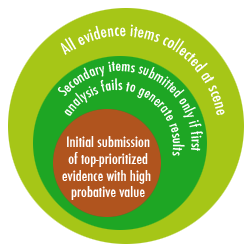Home | Glossary | Resources | Help | Contact Us | Course Map
Archival Notice
This is an archive page that is no longer being updated. It may contain outdated information and links may no longer function as originally intended.
Limiting the Amount and Type of Evidence
If a case is accepted by policy or exception, the evidence a laboratory accepts from that case may be limited. Laboratories may set a maximum number of items that will initially be worked for any case. The intent of limiting evidence items is to encourage the submitting agency to request analysis on only the most probative and potentially most informative items. For example, in a sexual assault case, depending on the circumstances, the crime laboratory may accept only the sexual assault kit for the initial round of testing.
Usually, these policies allow and encourage submission of additional items if the first analysis is not informative. Laboratory policies may allow analyses to continue until a DNA profile is found that places the suspect at the scene or until all items have been tested.
Additional Online Courses
- What Every First Responding Officer Should Know About DNA Evidence
- Collecting DNA Evidence at Property Crime Scenes
- DNA – A Prosecutor’s Practice Notebook
- Crime Scene and DNA Basics
- Laboratory Safety Programs
- DNA Amplification
- Population Genetics and Statistics
- Non-STR DNA Markers: SNPs, Y-STRs, LCN and mtDNA
- Firearms Examiner Training
- Forensic DNA Education for Law Enforcement Decisionmakers
- What Every Investigator and Evidence Technician Should Know About DNA Evidence
- Principles of Forensic DNA for Officers of the Court
- Law 101: Legal Guide for the Forensic Expert
- Laboratory Orientation and Testing of Body Fluids and Tissues
- DNA Extraction and Quantitation
- STR Data Analysis and Interpretation
- Communication Skills, Report Writing, and Courtroom Testimony
- Español for Law Enforcement
- Amplified DNA Product Separation for Forensic Analysts


